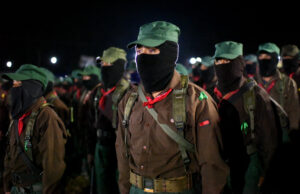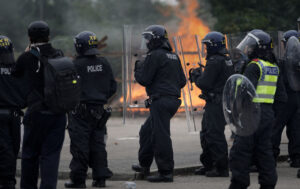On Friday 26 September 2014, a group of Mexican students boarded buses in the town of Iguala. Members of the Ayotzinapa Rural Teachers’ College, in the southern state of Guerrero, they were hoping to reach Mexico City for an event marking the anniversary of the infamous Tlatelolco massacre. On that day in 1968, hundreds of students were gunned down by the security forces, while others were tortured and falsely imprisoned. Some were simply disappeared, and never seen again. The outrage itself would soon be followed by a monumental cover-up, and ultimately become the defining event of recent Mexican history.
Little did the Ayotzinapa students know that history was about to repeat itself. As night fell, their buses were stopped by police barricades. There, on a lonely stretch of highway, they were set upon by officers and members of the local drug cartel. Many of the students were shot, a number were hospitalised, and one was found dead by the roadside, a part of his face ripped away. It was only the following morning, however, that the full scale of the horror became clear: 43 students couldn’t be accounted for. A decade on from their disappearance, they’re presumed dead. Their bodies have never been recovered.
If the Tlatelolco massacre became the defining moment of Mexico’s authoritarian past, “the 43” have come to symbolise the country’s stumbling democratic transition. There are, after all, over 110,000 desaparecidos (“disappeared ones”) right across Mexico, anonymous men and women who vanished one day and never came home. You’re reminded of them everywhere you go, their faces peering out at you from countless monochrome posters. Each, of course, represents a private tragedy. But just like Tlatelolco, the case of the Ayotzinapa students has gained vigour through the years, and ten years on represents abuse of state power at its most absolute.
Though Mexicans were disappeared in the Nineties, the modern epidemic of vanishings really started in 2006. That year, President Felipe Calderon declared a war on drugs. As gangs defended their turf, from both the police and each other, the republic was drowned in an ocean of blood. Over the next 18 years, Mexico suffered some 431,000 homicides, from random shootings to organised beheadings. Alongside the violence, disappearances have been normalised too. Alongside those 113,000 desaparecidos, after all, 4,000 clandestine graves have also been found.
Mexico’s drug cartels are clearly to blame for the mayhem — yet it’s not quite right to see them as straightforward criminals. Their influence is so powerful that it’s nowadays impossible to draw clear lines between cops and crooks. At every single level of government, from the police to the judiciary, there have been countless examples of collusion between officials and the cartels. Indeed Los Zetas, one of the most powerful and brutal of all the gangs, actually emerged out of an elite battalion of soldiers. Trained in counterinsurgency and drug war tactics, the troops then used that knowledge to become one of the most feared cartels around.
Given these blurred lines, it makes sense that investigations into the missing 43 have gone nowhere, and have instead been met by denial, impunity and red herrings. Only six weeks after the outrage, Mexico’s attorney general famously presented what he called the “historic truth” — and announced the students’ bodies had been incinerated by a cartel, with their remains thrown down a nearby ravine. Yet forensic investigators from Argentina, leading experts in finding desaparecidos after their own country’s history, soon dismissed these claims.
In 2021, meanwhile, drone footage showed the apparent site of mass murder being prepared. First taken by the Mexican Navy, it later shows their presence alongside soldiers and the attorney general. The families of the victims had long suspected official involvement in the massacre, a position later taken by an independent enquiry into the event. Led by the Interdisciplinary Group of Independent Experts (GIEI), it concluded that the disappeared 43 amounted to a “state crime”.
Despite accepting some involvement, however, the Mexican government continues to insist that the truth of the disappeared is ultimately a case of cartel violence, and perhaps a few corrupt politicians and police officers seduced by the violent glitz of drugs. A timely reminder of this has been the recent re-arrest of Gildardo Lopez Astudillo. Kingpin of the Guerreros Unidos cartel, he was detained just a few weeks before the tenth anniversary of the Ayotzinapa attack, with the authorities presenting his capture as a definitive win in the search for truth.
As obfuscation over Ayotzinapa persists, meanwhile, all Mexico suffers. In a study on Colombia — a nation with over 100,000 desaparecidos of its own — the former US ambassador coined the phrase “narco-statization” to refer to a situation in which every aspect of life is shaped by the violence and corruption of the drug trade. That’s clear enough from one of the leading GIEI investigators into the Ayotzinapa disaster. As Carlos Beristain has publicly noted, the moment his inquiry got too close to pinpointing state involvement, and especially military involvement, requests for information went unanswered.
Considering all this, it’d be easy to see the case of the 43 is a quintessential example of state failure. Yet in his compelling book, Modernity and the Holocaust, Zygmunt Bauman showed how the first systematic attempt to disappear an entire people couldn’t happen without meticulous planning and organisation. Disposing of human life isn’t straightforward. Rather, it requires a monstrous organisational effort to ensure the dead remain hidden. What we see in Mexico is not state failure, in short, but state excessiveness and impunity.
That’s especially true when you recall that violence doesn’t actually come easily to humans. We are far from natural born killers. As with other forms of systematically enforced and culturally normalised violence, rather, disappearance thrives when it’s a learned practice. This requires us to situate the disaster in Mexico in a far broader historical and geographical framing.
In mapping out the global topography of disappearance, our journey could plausibly begin in Nazi Germany. From there, we might follow ex-Nazis down the so-called “ratlines” to safety in South America. Certainly, not enough attention has been given to links between former National Socialists and the Argentinian junta, who also disappeared a number of Jewish activists and intellectuals through the Seventies. Then, like Che Guevara, we could travel up the spine of the Andes, learning how disappearance was remastered and exported, and how many of its advocates were students at the US military training facility now infamously called the “School of the Americas”.
Like all violence, the practice of disappearance has taken new forms as societies have changed. As Latin American countries have been transformed by the globalising logic of the free market, for instance, violence itself has been privatised. Just like global capital, meanwhile bloodshed has moved with the markets, from Colombia to Mexico to the frontiers of the US itself.
The geography of violence, in turn, has shaped how it’s counted. Keen to show how he brought peace and stability to Mexico, President Andreas Manual Lopez Obrador came to power promising to find the 43. Along the way, he founded the National Search Commission, and in one of his final official acts tasked it with reorganising Mexico’s disappeared into a more “accurate” picture. Unsurprisingly, the numbers fell dramatically. At just 12,377, the National Search Commission clearly used a politically motivated methodology. Families, for their part, responded to this development by decrying “the disappearance of the disappeared”.
This is far from just a Mexican problem. A few months ago, I was part of an organising committee leading an international conference on disappearance in Belfast. Hosting the event in Northern Ireland was significant — not least given the acknowledgment the UK isn’t immune to the practice either. As Padraig Og O Ruairc’s recent book on the disappeared of Ireland vividly shows, it’s a technique the British government (and its opponents) have employed for centuries, and on a scale unknown even during the Troubles. The Belfast event was opened by testimonies from two women. The first, Elizabeth Santander, described how her husband was vanished by the Colombian state in the Eighties. Dympna Kerr, for her part, explained how she’s still searching for her 19-year-old brother Columba McVeigh, murdered and secretly buried by the IRA in 1975.
Having spoken with such courage about the weight of absence, I was especially struck by how both women ended their testimonies with poetry. Apart from the beauty of their words, it reminded me how important art has become for the vanished of Mexico, with no local artist more dedicated to confronting the horrors of disappearance than Chantal Meza. In splattered flashes of red and grey, her paintings are a howl of grief for the 43 and every desaparecido. It’s appropriate, then, that today her extensive State of Disappearance collection is unveiled in the Chancellors Building at the University of Bath. A decade on from their final bus ride, it’s heartening to know that the Ayotzinapa students haven’t fully been forgotten.
Disclaimer
Some of the posts we share are controversial and we do not necessarily agree with them in the whole extend. Sometimes we agree with the content or part of it but we do not agree with the narration or language. Nevertheless we find them somehow interesting, valuable and/or informative or we share them, because we strongly believe in freedom of speech, free press and journalism. We strongly encourage you to have a critical approach to all the content, do your own research and analysis to build your own opinion.
We would be glad to have your feedback.
Source: UnHerd Read the original article here: https://unherd.com/




